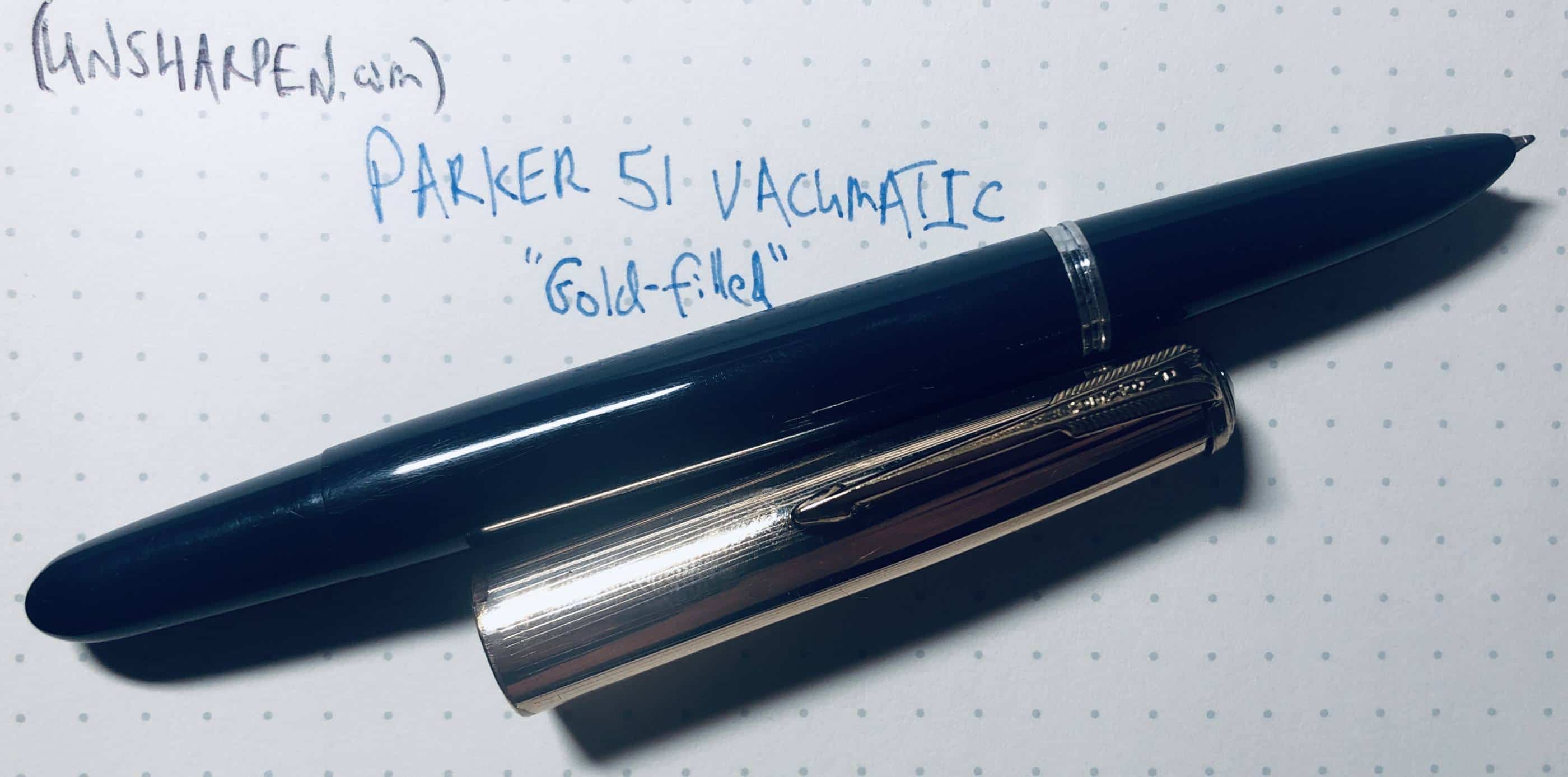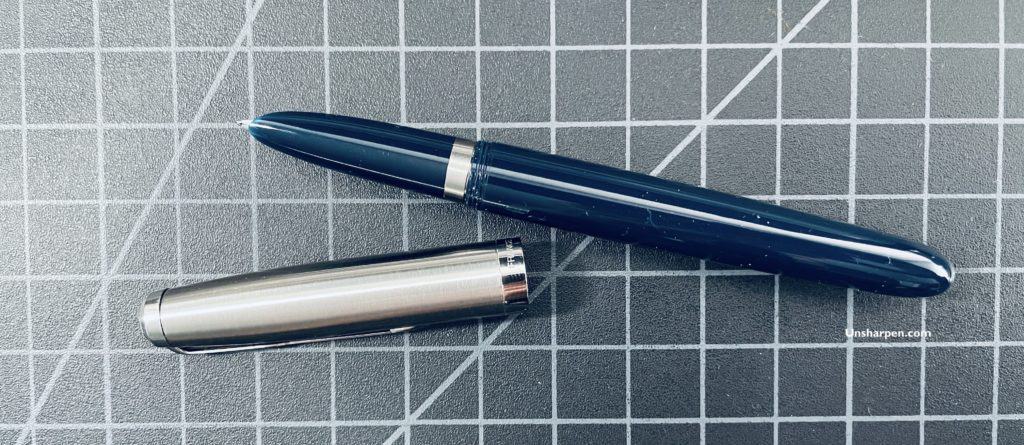The Parker 51 was a fountain pen produced by the Parker Pen Company, of Janesville, Wisconsin, from 1941 through 1972. The Parker 51 was sold with aerometric and vacumatic filling systems and also had a hooded nib, which kept most of the nib hidden under the pen’s plastic body.
The Parker 51 is a very popular pen with fountain pen collectors and is one of the most famous fountain pens of all time.
Parker 51 Name Origin
It might seem confusing that the Parker 51 was released in 1941, but there is a perfectly sensible reason: the pen was developed in 1939, the Parker Pen Company’s 51st year after being founded. So the name marks the birthday of the pen company, not the year the pen was released.
The name is also confusing because the Parker 51 was sold with a vacumatic filling system, but there is completely separate pen known as the Parker Vacumatic. This pen was Parker’s flagship from 1933 through 1941, before which it was known as the Vacuum Filler.
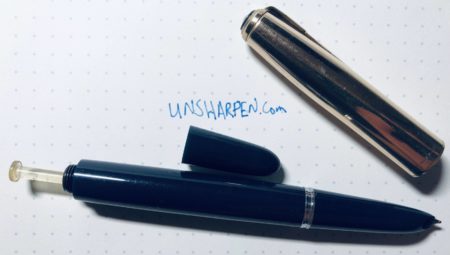
Parker 51 Prominent Features
The Parker 51 is an iconic pen due to its overall design, but it has a number of distinctive features associated with it.
Aerometric Filling System
Introduced in 1948, this is one of the two filling systems used by the Parker 51. This system used a push button (known as the “pressure bar”) on the side of the pen’s interior, which could only be seen with the barrel of the pen removed. By submerging the tip of the pen in ink, pressing the bar, and then letting go, ink would be sucked into the inside of the pen’s rubber sac.
The ink is held inside of a rubber sac and there is no actual spring inside, but rather a springy steel bar that goes across the sac, which would press it down and then return to its original position to suck ink inside. By pressing multiple times on the bar with the tip submerged the maximum ink capacity could be held.
The instructions were printed on the inside of the pen, directly into the body of the aerometric filler:
To Fill
Press Ribber Bar
Firmly Four Times
Holding Pen Point
Down, Wipe Point
With Soft Tissue
Vacumatic Filling System
This is the push-button filling system that looks like the more advanced of the two designs featured in the P51, but is actually the older design (the pen was introduced in 1941 with this system). This is the filling system featured in the Marlin S. Baker’s 1939 patent as well.
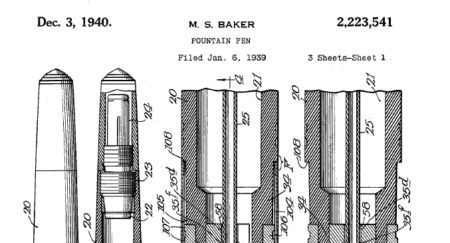
The vacumatic system has a push button at the top of the interior of the pen. To fill the pen the user simply needs to submerge the tip of the pen in ink, press the button, and then let go of the button, allowing it to return to its original position. On the return it will fill the interior with ink. The vacumatic system also has a small rubber diaphragm, inside that takes in the ink.
At the release of the pen this system was known as the “Foto-fill Filler” system and was lauded for only having a single moving part.
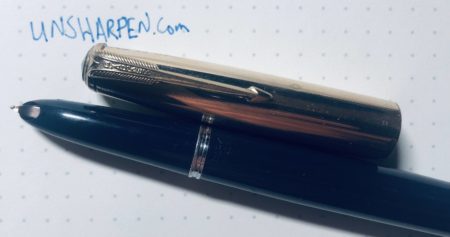
Hooded Nib
The Parker 51 does not have a large, highly stylized nib like many classic fountain pens. This was a workhorse pen, used when fountain pens were daily tools. In 1941 this took form in a 14K gold tubular nib, most of which was concealed within the body of the pen. The nib works with a collector shell, breather tube, and feed to produce smooth, even writing.
The nib is called “hood” because the grip section of then pen hides most of it from view, similar to on the newer Lamy 2000. It’s called tubular because it’s literally shaped like a tube that wraps entirely around the feed. This is usually done to delay the drying of ink that is still inside the pen. This was specially useful with the 51 pens because it was released alongside new, quick-drying inks. These were the Parker SuperChrome inks, which are now know to be harmful to pens and paper alike due to their high acidity and corrosive nature.
Parker 51 Versions
A large number of P51 variants exist and telling them apart from one another isn’t always easy. That said, there are some major classes of 51s what are worth understanding.
- First Year: These were the P51s sold in 1940-1941. They have a vacumatic fill and they are almost always a “double jewel” which is to say that they have a jewel piece on the cap and the bottom of the pen. The jewel is usually made of aluminum and would generally be called a finial today. These also have a larger than average diamond on the top of the clip, usually in blue. The fill button on these early pens will be aluminum, just like those found on the Parker Vacumatic.
- Vacumatic: They have the older filling system based on the combination of a rubber sac and a push button that is hidden under a blind cap that unscrews from the to top of the pen.
- Aerometric: The new filling mechanism. Also based around a rubber sac, but using a pressure bar and full removable barrel.
- Gold-filled: A Parker 51 with a gold cap. The cap is not gold-plated, but “gold-filled” which means a thicker plating of gold is used. The cap is not solid gold.
- Flighter: A full stainless steel P51
Parker 51 2021 Edition
In 2021 the Parker 51 fountain pen was re-released in two versions — one with a stainless steel nib (about $80) and another with an 18K gold nib (about $250).
The pens are clearly inspired by the original Parker 51 but have some major changes from the original.
Difference include:
- a lighter weight, more modern plastic used on the body
- moved from a friction fit cap to a screw-on cap
- the fill systems were replaced with a cartridge/converter
- no jewels or any of the features that made the original 51s so collectible
- new nib cannot easily be taken apart
The pen is a reliable writer and is always ready to go (so long as the cap stays on), but it lacks the style and flair of the original. The steel nib is quite stiff with no spring and adds to the no-nonsense behavior of the pen. We tested the pen in medium where it seems to be a better, more reliable writer than in fine size.
While this pen is well-behaved and has a classy styling, it’s difficult to justify the price when Parker 51 clones, like the Jinhao 85 and the Wing Sung 601, can be had for under $10. There are also significant downgrades from the original, including the use of a much lower quality resin in the body, allowing it to pickup scratches easily.
Maybe people have complained about the price in regards to the pen’s nib, which seems to the nearly identical to the nib used on the $20 Parker Jotter fountain pen. This makes the pen a difficult one to recommend for all but the most diehard Parker fans.
Parker 51 Fountain Pen Information
| Street Price | Check Price |
| Manufacturer | Parker |
| Pen Type | Fountain Pen | Vacuum (built-in), Piston (built-in) |
| Rating | |
| Barrel Color | Black, Brushed Steel, Blue, Green, Mustard, White, Red |
| Barrel Material | Plastic |
| Grip Color | Black |
| Grip Material | Plastic |
| Country of Origin | USA |
| MSRP | $50 |
| Still Sold | Yes |
| Release Year | 1941 |
| Similar To | |
| Refills | |
| Capped? Retractable? | Capped - Snap On |
| Clip? | Metal |
| Weight (g) | |
| Nib Material | |
| Nib Color | |
| Nib Sizes | |
